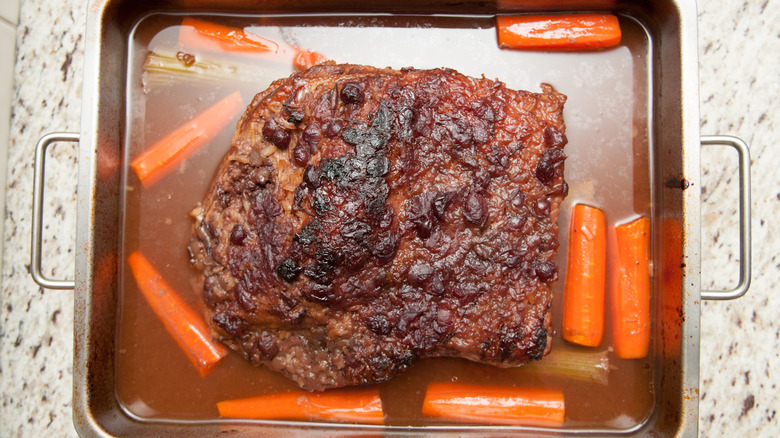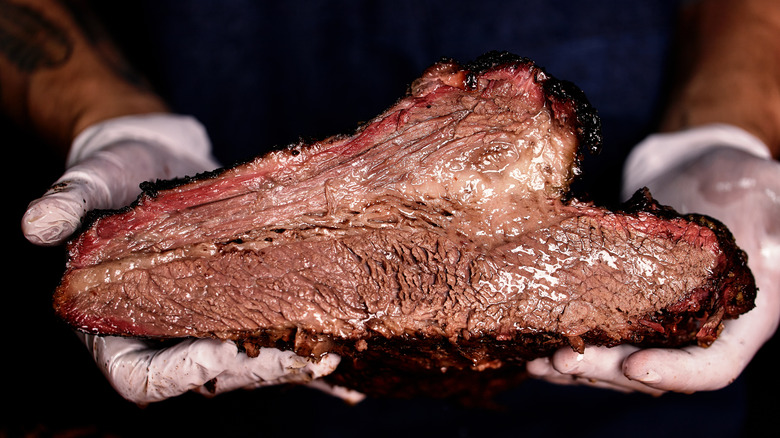The Passover Dish Andrew Zimmern's Family Asked Him To Never Make Again - Exclusive
It's not always a good idea to mess around with tradition, as Emmy and four-time James Beard Award-winning chef and food television icon Andrew Zimmern found out the hard way on Passover. Daily Meal spoke to Zimmern at the Nassau Paradise Island Wine and Food Fest's Taste of Paradise event, and he told us all about it in an exclusive interview. "I still do a brisket [for Passover] because everyone in my family is like, 'We have to have the brisket,'" Zimmern told us. "If I try to change that, there would be open revolt in my house. I did goose one year and everyone loved it. And they said 'That was great. Never do it again.'" What's interesting is that, even with goose, Zimmern was still very much working in Jewish tradition.
While not a traditional holiday dish like beef brisket, goose has a long and honored history in Old World Yiddish cooking, and often featured in German and Eastern European Hanukkah feasts. Latkes were fried in goose fat; foie gras was eaten at Passover; and, in Romania at least, it was goose — not brisket — that was cured and smoked to make pastrami. Still, the Zimmern family's expectations are clearly informed by the tradition they grew up with as much as their good taste.
Brisket is beloved for a reason
Beef brisket is not just a traditional Passover dish; it also appears during the Jewish new year's celebration of Rosh Hashanah. There are good reasons for this, apart from the fact that a well-made brisket, cooked slowly with aromatics, is exquisitely tender and flavorful. For one thing, brisket is inherently kosher because it comes from the front of the cow (specifically, the lower chest area) — and nothing from an animal's hindquarters will qualify. Secondly, weighing in excess of ten pounds, a beef brisket is a big cut of meat and not suitable for everyday cooking. Of course, this makes it ideal for large gatherings like holiday celebrations.
Lastly, the very qualities that can make brisket so juicy and tender also make it inexpensive: These cuts are fatty and shot through with connective tissue. Because of this, it's not terribly difficult for brisket to turn out tough and chewy — and this might happen more often than some families are willing to admit (not counting the Zimmern's, of course, whose meals are in good hands). In fact, the word brisket derives from the Old Norse "brjósk," which literally means "cartilage." Throwing a beef brisket on the grill — or using any kind of high-heat cooking application — will result in shoe leather for dinner.
A tradition begets a tradition
Because it's necessary to render out a brisket's fat and connective tissue, there's only one cooking strategy that will work: low and slow. This means, for holidays like Passover and Rosh Hashanah, the meat is braised for hours until you get the perfect brisket — glistening and meltingly tender. But brisket can also be smoked, as any pastrami lover will tell you.
Smoking and curing meat is an age-old method of preservation, and it appears that pastrami has very ancient roots indeed, going all the way back to a spiced, cured, and smoked meat (usually beef or mutton) that the Ottoman Turks called pastirma. When Romanians got their hands on it they switched the meat — voilà, goose pastrami.
Once pastrami made its way to the New World via Ashkenazi Jewish refugees, it became not only an American deli staple but inspiration for the entire barbecue culture of Texas. In the early 1900s, two Texan delis — Watson's Grocery in El Paso and Naud Burnett's in Greenville — were offering smoked brisket alongside other Jewish dishes. By the 1950s, Black's BBQ in Lockhart was offering smoked brisket on its (non-kosher) menu, and Texas brisket, a Southern barbecue tradition, was born.


